1. Introduction
The table tennis is one of the most famous sport balls in the world. It is a kind of spectator competition that can make the audiences unforgettable. A formal Olympic table tennis match adopt four wins in seven rounds for single games, while the team game of table tennis is best of five. Beside the Olympics games, there are also many famous competitions for table tennis such as the Table Tennis World Cup and the Table Tennis Championship. Table tennis is the national game of China and an important event appeared to Chinese tennis team that Guotuan Rong got champion in the 25th world Table tennis Championships at Dortmund in 1959 [1]. Unsurprisingly, the Chinese tam returned to the world competition in April 1971 and became even more unstoppable. The Chinese team almost toke over the table tennis gold medals in the world Table Tennis Championships. Therefore, there were some special alterations with table tennis regulations since 1981. For example, the diameter of ping-pong balls became bigger from 38mm to 40mm in order to restrict the spin of the balls and the speed of the ball in 2000. Initially, the Chinese table tennis team could not adapt to the speed of the ball because they preferred the ball with 38mm of diameter. In the next year, there was another alteration on the competition system which is every round reduced to 11 points which would greatly increase the contingency of the game. It also was not a beneficial news for Chinese players. According to professional knowledge, these alterations are based on aerodynamics. And because of the aerodynamics, the arc spinning balls can be split into topspin ball, backspin ball and side spin ball. They have different attacking angle and strike strength.
2. Literature review
2.1. What is aerodynamics?
Aerodynamics is a branch of fluid mechanics, which mainly studies the mechanical characteristics, gas flow law and the accompanying physical and chemical changes of objects in relative motion with gas. It is a discipline which grows up with the development of aviation industry and jet propulsion technology based on fluid mechanics. The aerodynamics can be divided into two broad categories. Depending on whether the viscosity of the gas medium must be considered in the flow, aerodynamics can be divided into ideal aerodynamics and viscous aerodynamics. At room temperature and pressure, the actual volume of gas molecules and the interaction between molecules can be neglected, which would be the ideal aerodynamics. Aerodynamics also can be divided into high speed aerodynamics and low speed aerodynamics according to air speed. In low-speed aerodynamics, the gaseous medium can be considered non-compressible, and the corresponding flow is called non-compressible flow. For flows greater than this velocity, compressibility effects and changes in thermodynamic properties of gas must be considered. This flow corresponding to high-speed aerodynamics is called compressible flow. What is more, the aerodynamics can be divided to aircraft aerodynamics, industrial aerodynamics and automotive aerodynamics, which is based on application. In the late seventeenth century, there was a physicist called Huygens from Holland, who was the first person that put forward the theory of aerodynamics. He estimated the magnitude of resistance that objects received in the air. In 1726, one of the most famous physicists Newton applied the principle of mechanics and deductive method to conclude that the force of the object moving in the air is proportional to the square of the object’s speed and the characteristic area of the object and density of the air. That can be expressed as:
\( {F=ρAV^{2}} \) (1)
In this equation, F represents the force that exerted on the object. V, ρ and A represent the velocity, density and area of the object respectively. This result can be regarded as the beginning of classical theory of aerodynamics. The differential equations for the motion of viscous fluids were given by mathematician Euler in 1755. Besides, the equation of motion for momentum conservation of non-compressible fluids was given by Navier from France and Stokes from the UK in 19th century. By the end of 19th century, the foundations of classical fluid mechanics had been formed. As the development of technology, I find that I can use aerodynamics to explain many phenomena and there are some applications that introduced in following paragraph. Aerodynamics can be applied on following aspects: the airplane, the architecture and environmental protection [2].
2.2. Bernoulli principle
Bernoulli principle is an important theory in fluid mechanics. Daniel Bernoulli proposed Bernoulli principle in 1726. In order to publishing this principle, he put lots of efforts into fluid mechanics and did many experiments. Bernoulli principle is a theorem that expresses the conservation of total energy along a streamline when a non-viscous positive pressure fluid moves at a constant length under the action of a potential external force. And the Bernoulli principle was also the basic principle used in hydraulics before the continuum theoretical equations of fluid mechanics were established. The Bernoulli principle main tells as that the higher velocity part will produce lower pressure. The essence is the conservation of mechanical energy of the fluid that the sum of kinetic energy, potential energy and stress potential energy are equal to a constant, which can be written as:
\( {p+ρgℎ+\frac{1}{2}ρV^{2}}=C \) (2)
In this equation, p、ρ、v represent the fluid pressure, density, speed respectively. The symbols ‘h’ and ‘g’ express as height and acceleration of gravity. Fluid viscosity can be ignored if there is no heating or cooling fluid flow in the system. The fluid density is constant. So this is an ideal isentropic flow in an non-compressible fluid system and inside. The energy stays the same. In this case, the energy equation for the mechanical energy balance is the Bernoulli equation. The pressure will be lower as a higher flow velocity. Bernoulli principle can also be expressed as below:
\( {p_{1}}+ρg{ℎ_{1}}+\frac{1}{2}ρV_{1}^{2}={p_{2}}+\frac{1}{2}ρV_{2}^{2}+ρg{ℎ_{2}} \) (3)
As shown in figure 1, the energy per unit volume before is equal to the energy per unit volume after. According to Bernoulli's principle when non-compressible ideal gas flows steady-state along a flow tube, the static pressure of the fluid decreases as the flow velocity increases. On the contrary, when the flow velocity decreases, the static pressure of the fluid will increase.
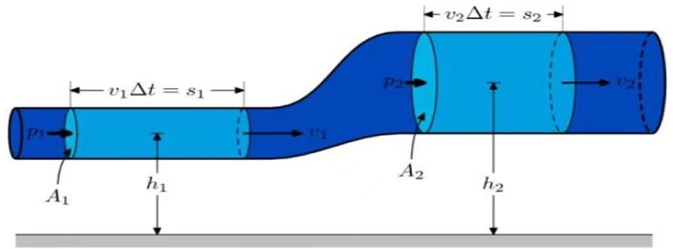
Figure 1 The Bernoulli principle in a pipe.
2.3. Magnus effect
There is another principle that influence the trajectory of ping-pang balls in the air and the founder gave its name Magnus effect. Isaac Newton described and correctly deduced the cause of this phenomenon as early as 1672 after watching Cambridge tennis players’ competition [3]. In 1742, an engineer majored in firearms from British who called Benjamin Robins explained the deviation the trajectory of musket balls in the Magnus effect. The Magnus effect is when the rotational angular velocity vector of a rotating object does not coincide with the object's flight velocity vector, a transverse force will be generated in the direction perpendicular to the plane composed of the rotational angular velocity vector and the dynamic velocity vector. For example, the trajectory of football that like a banana kick. As you can see from figure 5, the airflow direction and spin direction of the football are same, the velocity of airflow is V and the airflow will remain V when the football passed. The football is a rotating around the centre of mass and the velocity of airflow will change differently. And U is assumed to be the velocity on the surface of the ball. Therefore, the velocity of upper part of the airflow is V+U, which is larger than initial airflow velocity V. And the lower part of the airflow is V-U. According to Bernoulli principle, the static pressure of the fluid decreases as the flow velocity increases, so the pressure at the top of the football is lower than the pressure on the lower surface. Therefore, the ball will tilt upward under the pressure.
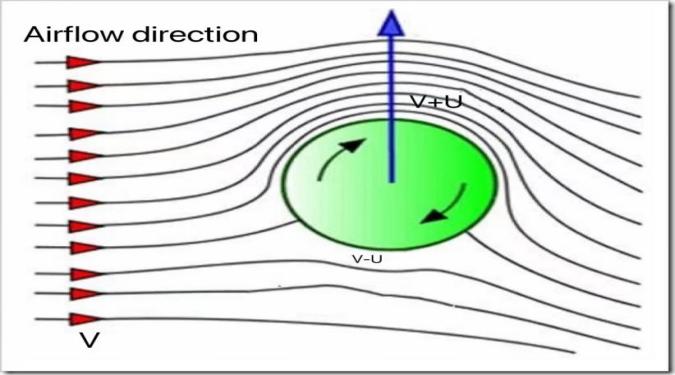
Figure 2 A example of a back-spin ball.
In addition, the Magnus effect is also used in rotating missile. For instance, the antitank missile needs to rotate around the axis of symmetry during the flight. Although magnus forces are generally small, magnus moments have an important effect on flight stability. Therefore, the magnus phenomenon is studied deeply and the Magnus force and Magnus moment are predicted accurately. Minimizing the adverse effects of the Small Magnus effect on projectile flight has important effects on projectile design, ballistic budget and strike accuracy [4].
3. Discussion
3.1. How does the size of the ball affect the speed and trajectory of the ball?
Due to Chinese teams can get the majority of the table tennis competitions medals, the ITTF had changed the size of the ball in 2000. The ITTF decided to use a ping-pong ball with 40mm diameter. There is no denying that the most affected team is Chinese Ping-Pong Team, since there was a huge change on the speed of the ball. Therefore, the Chinese teams cannot use the speed advantage anymore. Nowadays, a standard ping pong ball has a weight of 2.7g with a diameter of 40mm. Table tennis travels fast and demands quick reactions. The typical time it takes for a ping pong ball to fly across a table approaches the limit of human reaction time of about a quarter of a second. Because every millisecond is very important in competitions that can cause different endings. The ball obtains the air resistance and gravity while it is moving in the air. The size will influence the speed of balls that increase the windward area. According to empirical formula for drag:
F =½CρS (4)
In which, F is the air resistance, C is drag coefficient, ρ is air density, S is windward area, and V is the relative speed of a body moving with air .We can find the air resistance will increase with the increase of windward area. According to the International Table Tennis Federation, the diameter has been changed from 38mm to 40mm in 2000. And the mass is is 1/9 larger than before, changing from 2.5g to 2.7g. This will be followed by a revolution in equipment, floor, sponge and rubber. At the same time, there will be a corresponding adjustment in tactics. In any case, the overall direction of the development of table tennis is still toward faster, more revolving development. Larger ball causes the speed, rotation and power have a huge change. The balls with a diameter 38mm can achieve larger speed and rotation speed. Until the emergence of the larger diameter ball that restricts the speed and the power of rotary. Data shows that after changing to 40mm ball, the average speed of table tennis can be reduced by 13% and the rotate speed can be reduced by 23%. What is more, the probability of catching the balls can be increased by 30%, which fundamentally improves the number of rounds hit and ornamental value. Therefore, the player will be given extra milliseconds to react with the balls. When a non-spin ball flies through the air, its path is similar to that of a flat projectile. But due to a larger diameter, its landing point is earlier and its highest point is lower as it rises. Curve b, as shown in figure 6, is the motion track of the sphere with air resistance and curve a is the motion curve of the sphere without air resistance. Both a and b have the same diameter of the ping-pong ball. If we compared the curve b and c that has a larger diameter than b, the landing point of c will be closer to the beginning point. Because a ball with a large diameter also has large windward area, which means the curve c will fall faster than curve b. To conclude, the ball will receive more air resistance as the diameter of ball is increasing. The speed of the ball that come to zero will be faster and have a shorter movement after launch. Thus, the larger diameter will reduce the ball’s speed and have an earlier falling point.
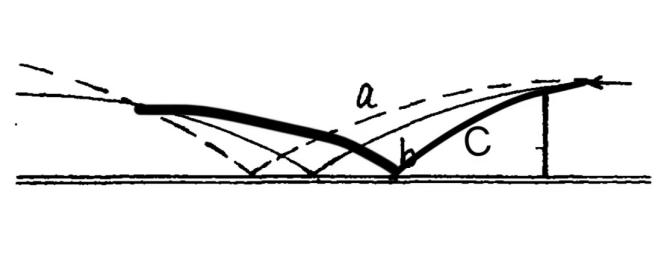
Figure 3 Compare the ping-pong balls of 38mm and 40mm and the alteration of the air resistance.
According to the data in table 1, for table tennis with diameter of 40mm can achieve 17 m/s for forehand smash, while diameter 38 mm ping-pong ball forehand smash speed is 17. 8 m/s [5]. For serving a top-spin ball with diameters of 40 mm, the spin rate is 48r/s. The table tennis ball with straight diameter of 38mm spin rate of the is speed of 60r/s. For serving a back-spin ball, the spin rate of 40mm and 38mm are 59r/s and 74r/s respectively. What is more, the highest of forehand loop can achieve at 36.3m/s with diameters of 40mm and 42.2m/s with diameters of 38mm. Finally, when the table tennis players were smashed a lob, the speed can reach 33.2m/s and 37.8m/s with a diameter of 40mm and 38mm respectively.
Table 1 Compare different kinds of arc spinning balls with a different diameters.
Forehand smash | Serve a top-spin ball | Serve a back-spin ball | Highest speed of forehand loop | Smash a lob | |
38 mm | 17.8m/s | 60r/s | 74r/s | 42.2m/s | 37.8m/s |
40 mm | 17m/s | 48r/s | 59r/s | 36.3m/s | 33.2m/s |
To conclude, the ball with 40mm diameter will have a slower speed and spin rate. The 40 mm ball is 1/5 less rotating and 1/7 slower than the original 38 mm ball. Ping-pong balls with large diameters rotate and run less than those with small diameters. If the diameter of the table tennis ball is increased, it will reduce the difficulty of the players and have more splendid moment.
3.2. Topspin ball, backspin ball generation principle and striking way.
In addition to quick attack to win the table tennis competitions,there are some arc spinning balls that is popular in the table tennis region. A good player usually uses different varieties of spin to play, which will cause the ball to fly in different trajectories such as the topspin balls and backspin balls. Because a spinning ball flies differently from a non-spinning ball, the spin ball is difficult to react. In competitions, the back-spin and top-spin balls also can help the players to defense or attack. They can be regarded as a tactical set of the games. For example, in the semifinals of the 2013 National, Zhendong Fan from Chinese Team won the match and defeated Xin Xu with a fast topspin. What is more, the top spin or back spin can change the direction of rotation while a side spin ball is coming from opponents. If you just return the top-spin or back-spin ball normally, the ball will go up or down after contacting with the racket. Therefore, top-spin ball and back-spin ball are useful for players to deal with the poor situation. The definition of top-spin ball is when the racket touches the top of the ball and the ball spins forward and hits the table before accelerating. While the definition of back-spin ball when the racket touches the below of the ball so that it spins backwards and rebounds to opponent’s table part. Top-spin and back-spin balls are in the process of hitting the ball, if the frictional force between the racket and the ball is greater than the front impact force between the racket and the ball, then the ball will obtain a strong Magnus force after flying out. In figure 7, two dotted lines are the trajectories of a non-spinning ball. We can easily see the difference between two pictures that back spin moves upward and top spin moves downward. As shown in this picture, there are gravity, air resistance force and Magnus force on the ball. For the top-spin ball at the top of figure, the ball will have a downward trend of trajectory compared to the dotted line because the Magnus force is downward. For the back-spin ball at the bottom of figure, the ball will have a upward trend of trajectory the compared to the dotted line because the Magnus force is upward.
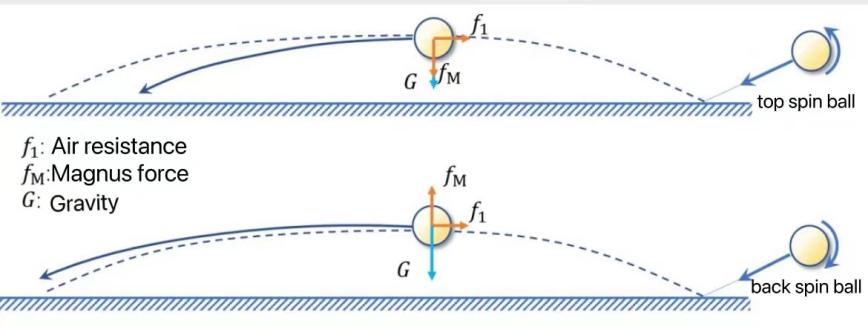
Figure 4 Two trajectories of top-spin ball and back-spin ball.
As shown in Figure 8, these are top-spin and back-spin balls in the air. And as the ball is rotating and forming air circulation around the ball.The topspin ball at the left-hand of the figure will move in the same direction as the spin. The rotation of the ball is clockwise and the direction of airflow is to the left. At the same time, the direction of rotation of the upper surface of the top-spin ball has oppositely direction with airflow. But the direction of rotation of lower surface has the same direction with airflow. Therefore, the combined result is that the upper surface’ air is moving at a lower velocity and the lower surface’s air is moving at a higher velocity. According to Bernoulli's equation, where the flow rate is high, the pressure is low, so the ball of pressure on the upper surface is larger than lower surface. The ball will also gain a corresponding downward Magnus force because of the pressure difference. When the ball is a back-spin ball, the upper part of the air will have a higher velocity. On the lower half of the ball, because the oncoming air flow and the rotation of the ball are in the opposite direction, the air slows down the flow rate, which causes the pressure increases. This evidence shows that by introducing backspin to the table tennis ball, an upward Magnus force is created. The upward lift also allows the ball to travel farther [6].

Figure 5 Specific process of top-spin ball and back-spin ball.
The drop point will also change because of different trajectories. If there is no velocity difference between upper surface and lower surface , the drop points of the balls are depended on the force that players exerted. While it is a top-spin ball, the upper air pressure of the sphere is larger than the under air pressure due to the velocity difference. Thus, changing the curvature of the arc and the flight distance of the ball will be shorter. In addition, there is going to be less pressure upper surface of the back-spin ball. So when the ball flies in the air, it is constantly affected by the action of air lift and falls slowly and moves further. Thus, reducing the curvature of the arc and making the flight distance of the ball longer.
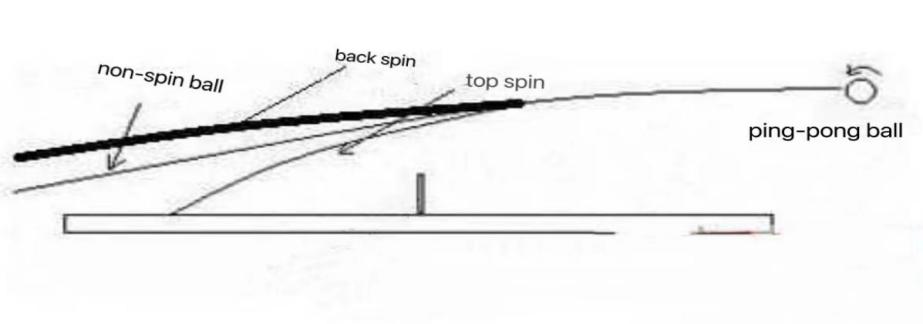
Figure 6 Different landing points of the arc spinning balls.
And there are four skills of producing a top-spin balls. These four skills are about how to grip the racket, toss, backswing and hit the ball. Firstly, the serve should be served with the continental or Eastern backhand grip and the racket face is clockwise with a semicircle. Such a grip makes it easy to serve topspin and side spin. This is the way that how to grip a racket correctly in order to giving out a top spin. Secondly, face the net and draw a circle with the racket in front of you. The server is required to throw the ball "near vertically" upwards and it must rise at least 16 cm after leaving his hand. On the other hand, the ball may be thrown overhead or even farther to the left for outside corners with the right hand. Throw the ball not too far forward, or even behind the head for extra spin. Thirdly, body is facing the front and the direction of the line between the toes is the direction of serving. The left hand throws the ball from the front of the body and the right hand leads the racket backward. Note that the elbow should be higher than the shoulder when leading the racket. Finally, swing the racket with your forearm, hit directly behind the ball, turn the wrist outwards to move the racket forward and bring the racket to the left of your body to complete the serve. At the same time, the knees begin to bend. The body sinks and leans backwards. These are all very important skills to a generate top-spin ball. For producing a back-spin ball, some skills are the same as producing a top-spin ball but the how to hit the ball is different. Because the core of producing a back spin ball is keeping the ball lower and turn more. If you want to serve a long backspin, try to place the first drop close to the end of the table so that the ball has a longer curve. When serving a backspin ball, the most important thing is to distinguish between impact and friction. Create as much friction as possible. To conclude, serving a top-spin ball or back-spin ball need to do it step by step. Therefore, a wonderful and unstoppable arc spinning balls will be produced. Besides, there are some people who are famous for back-spin and top-spin balls. For instance, in a match between Chinese player Jike Zhang and Japanese player Oshima Yuya, Jike Zhang won the first game of the third game after winning two games. It was Jike Zhang’s powerful backspin that created a tricky angle that made the Japanese player off balance. Top-spin balls are used a lot in competitions as well, for example, the match between the Chinese player Long Ma and Germany's Okcharov. Long Ma used the advantage of topspin to break Okcharov's serve. And the Germany’s Okcharov’s couldn’t response well because the ball was too close to the net.
3.3. The generating principle and striking mode of side spin ball
In the region of table tennis, the side spin balls are also useful in the competition. It can be the tool to reverse the poor situation. For example, the "The Marvelous" in 2020, a table tennis competition in China, Long Ma used side-spin to serve and defeated Qihao Zhou. The main reason is that Chinese player Long Ma adopted the characteristics of the side spin ball for his own attack advantage. The side spin ball is caused by a parallel swing of the racket and rub between the racket and the ball. In total, side spin balls can be divided into six different types: left spin, right spin, left top-spin, left back-spin, right top-spin, and right back-spin. And we can just talk about two side spin balls because they have similar theory. The server gives the ball a left or right friction force that causes it to spin left or right. A ball that spins to the left is called a left-spin ball. And a ball that spins to the right is called a right-spin ball. Firstly, there is a figure of left-spin ball in figure 9. According to the centroid motion theorem, the initial velocity must be to the left. During the movement of the ball, the left side of the ball airflow is opposite to the direction of the oncoming air flow. So the flow rate of the air will slow down. While the flow on the right side is in the same direction of oncoming air flow. So the flow rate of the air will increase. According to Bernoulli's equation, the slower the flow gains higher the pressure, while the higher the flow rate gains lower the pressure. The left side of the ball has higher pressure than the right side has low pressure, so the direction of Magnus force is to the right. And the trajectory of the ball will move to the right. Similarly in figure 10, the initial velocity of the right-side spin ball is to the right. During the movement of the ball, the right side of the ball airflow is opposite to the direction of the oncoming air flow. So the flow rate of the air will slow down. While the flow on the left side is in the same direction of oncoming air flow. So the flow rate of the air will increase. The right side of the ball has higher pressure than the left side, so the direction of Magnus force is to the left [7]. And the trajectory of the ball will move to the left [8].
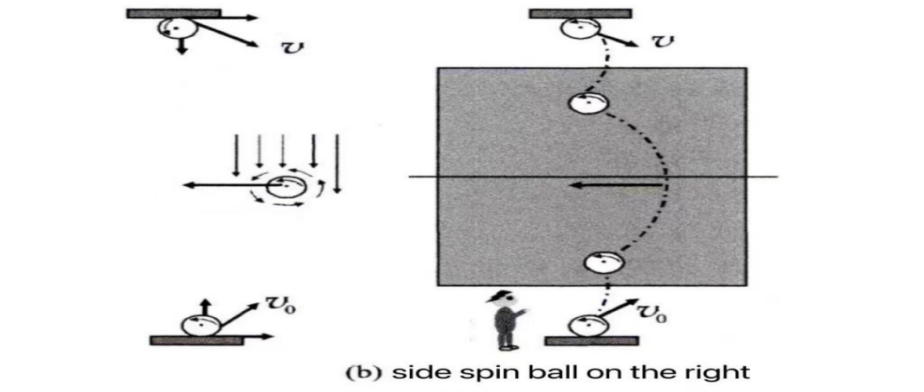
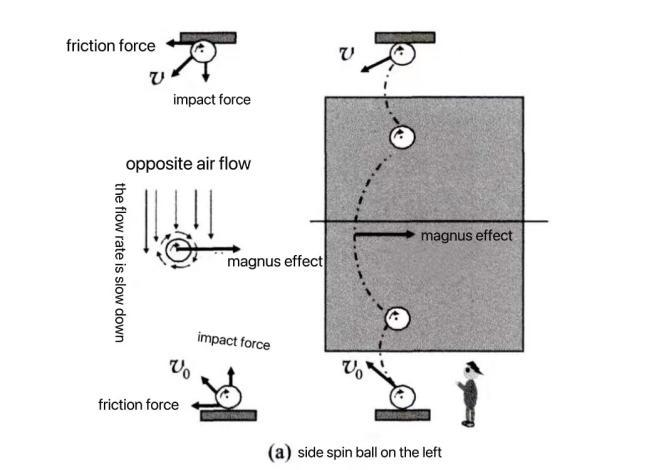
Figure 7 Trajectory of side spin ball on the left and side spin ball on the right.
Due to the rotation axis of the side spin ball is just perpendicular to the table and this part is the weakest area of the rotating region. Therefore, the lateral force of the rotating ball on the table can be almost ignored. Similarly, the lateral reaction of the table to the ball is almost negligible. So after the side spin balls first touch the table, they will move with a same direction as the initial velocity. For the left-spin ball, after touching the racket, the leftward friction will apply to the ball. For the right-spin ball, after touching the racket, the ball will also move to the right. There are three points about playing with a side spin ball on the left. Firstly, it is important to relax your wrists before serving and this is the key to friction. What is more, hold the racket with several fingers at the same time. Secondly, pay attention to the position of servicing a ball and the best batting point is slightly above the table. The third point is to reduce the arc of servicing of ball in order to increasing the difficulty of the other side to judge the ball and reduce the chance to smash the ball. The side spin ball on the right hand also has some playing skills that contain three parts. To begin with, stand on the left half of the table, right foot slightly forward or flat standing, the body slightly tilted to the left, left palm to support the ball in front of the body left. Secondly, when serve a side spin ball on the right, throwing the ball with left hand first. Swing your right arm from back left to top right while hitting the ball. A right-side topspin is served when the middle of the ball is rubbed up and to the right. A right-side backspin is served when the middle of the ball is rubbed down and to the right. Ning Ding beat Japan's Miyu Hirano 4-1 in the women's singles quarterfinal at the World Table Tennis Tour in Chengdu, China, on June 24, 2017. Ning Ding played relatively loose throughout the match because ding's side spin ball on the left played a significant role in her match.
4. Conclusion
This paper explained why the aerodynamics can influence the trajectory of the ball. And the alteration of trajectory is divided to three large aspects. The first is the diameter, second is top and spin balls and the third is side spin balls. These three factors are all can cause the different trajectories. What is more, the way that I chose to talk about in this paper is aerodynamics. Besides, the Magnus effect and Bernoulli theory are also the terminologies to analyse this phenomenon. In addition, analysis part is introducing the generation principle and striking way of four kinds of banana kick and 40mm of ping-pong ball bring a difference on players’ playing strategy and response time. It is not good news for Chinese table tennis teams. The research provides some insights into the analysis of balls’ trajectories. For my paper, it can be the sum of results that about table tennis. For instance, the drop points between top spin and back spin balls are difference on distance. It is good for the research of ping-pong balls that force condition in the air and which part of difference cause this. Therefore, the back spin ball has a further drop point. For table tennis competition, this paper can teach you some skills on getting point quickly. For stance, you can confuse the opponents by playing with different side spin balls because the opponent cannot distinguish tiny difference immediately. However, the paper also has some limitations that I did not get enough international resources about the table tennis. And most of the examples in my paper represent Chinese players. I still not summarize the achievements with a higher view. This is one of the limitations on my paper and I have more aspects to improve.
References
[1]. Xinghua website (2019-2-26) The history of Chinese table tennis. http://www.ctta.cn/zlk/2016/0728/122598.html
[2]. Nonomura, J. , Nakashima, A. , & Hayakawa, Y. . (2010). Analysis of effects of rebounds and aerodynamics for trajectory of table tennis ball. SICE Annual Conference 2010, Proceedings of. IEEE.
[3]. Wang J. Magnus research status (2020-12-15) Science and technology innovation and application.
[4]. Juan Mian Lei, Tiantian Li & Can Huang.(2013). Numerical study on magnus effect of high-speed rotating projectile. Acta Armamentarii (06),718-725.
[5]. Xiaopeng Zhang & Wu Huanqun.(1997). Influence of different diameters and weights of table tennis on hitting speed and rotation. Chinese Sports Science Society.(eds.) Abstracts of the fifth National Sports Science Congress (pp.255-256).
[6]. Ou, K. , Castonguay, P. , & Jameson, A. . (2013). Computational Sports Aerodynamics of a Moving Sphere: Simulating a Ping Pong Ball in Free Flight. 29th AIAA Applied Aerodynamics Conference.
[7]. Ma xiangli. (2017). Study on left backspin in table tennis. Contemporary Sports Science and Technology, 7(29), 3.
[8]. Li Li zhao, Dong Hua Fan, Yi Zhan Chen. Physics and engineering,2017,27(02).
Cite this article
Yang,Q. (2023). The effect of aerodynamics on table tennis. Theoretical and Natural Science,5,465-473.
Data availability
The datasets used and/or analyzed during the current study will be available from the authors upon reasonable request.
Disclaimer/Publisher's Note
The statements, opinions and data contained in all publications are solely those of the individual author(s) and contributor(s) and not of EWA Publishing and/or the editor(s). EWA Publishing and/or the editor(s) disclaim responsibility for any injury to people or property resulting from any ideas, methods, instructions or products referred to in the content.
About volume
Volume title: Proceedings of the 2nd International Conference on Computing Innovation and Applied Physics (CONF-CIAP 2023)
© 2024 by the author(s). Licensee EWA Publishing, Oxford, UK. This article is an open access article distributed under the terms and
conditions of the Creative Commons Attribution (CC BY) license. Authors who
publish this series agree to the following terms:
1. Authors retain copyright and grant the series right of first publication with the work simultaneously licensed under a Creative Commons
Attribution License that allows others to share the work with an acknowledgment of the work's authorship and initial publication in this
series.
2. Authors are able to enter into separate, additional contractual arrangements for the non-exclusive distribution of the series's published
version of the work (e.g., post it to an institutional repository or publish it in a book), with an acknowledgment of its initial
publication in this series.
3. Authors are permitted and encouraged to post their work online (e.g., in institutional repositories or on their website) prior to and
during the submission process, as it can lead to productive exchanges, as well as earlier and greater citation of published work (See
Open access policy for details).
References
[1]. Xinghua website (2019-2-26) The history of Chinese table tennis. http://www.ctta.cn/zlk/2016/0728/122598.html
[2]. Nonomura, J. , Nakashima, A. , & Hayakawa, Y. . (2010). Analysis of effects of rebounds and aerodynamics for trajectory of table tennis ball. SICE Annual Conference 2010, Proceedings of. IEEE.
[3]. Wang J. Magnus research status (2020-12-15) Science and technology innovation and application.
[4]. Juan Mian Lei, Tiantian Li & Can Huang.(2013). Numerical study on magnus effect of high-speed rotating projectile. Acta Armamentarii (06),718-725.
[5]. Xiaopeng Zhang & Wu Huanqun.(1997). Influence of different diameters and weights of table tennis on hitting speed and rotation. Chinese Sports Science Society.(eds.) Abstracts of the fifth National Sports Science Congress (pp.255-256).
[6]. Ou, K. , Castonguay, P. , & Jameson, A. . (2013). Computational Sports Aerodynamics of a Moving Sphere: Simulating a Ping Pong Ball in Free Flight. 29th AIAA Applied Aerodynamics Conference.
[7]. Ma xiangli. (2017). Study on left backspin in table tennis. Contemporary Sports Science and Technology, 7(29), 3.
[8]. Li Li zhao, Dong Hua Fan, Yi Zhan Chen. Physics and engineering,2017,27(02).









